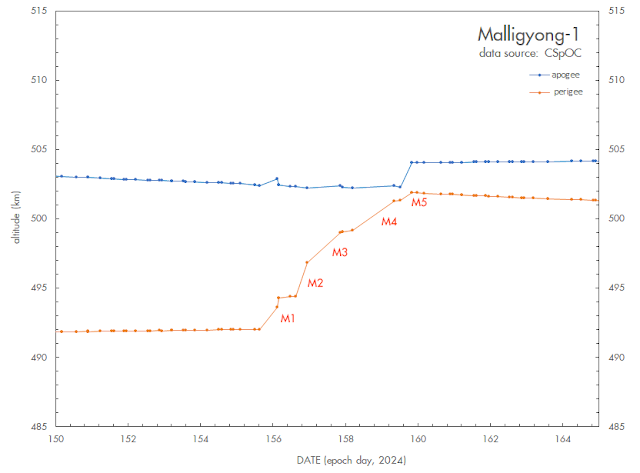 |
| click diagram to enlarge |
Early February 2024, the North Korean satellite Malligyong-1 (2023-179A) made a series of orbital raising manoeuvers, the first we have ever seen a North Korean satellite do. I wrote about the character and significance of it at the time in two brief articles in The Space Review, which you can read here (part 1) and here (part II).
And now Maligyong-1 has raised its orbit again, in early June, slightly over 3 months after the February orbit raise. As was the case for the February orbit raise, it was done in five increments, one on each successive day, the first incremental raise in this series happening on June 3 and the last on June 7, 2024. The fifth and last of the June incremental raises also raised the apogee, by 1.6 km, something that did not happen during the previous orbit raise in February.
 |
| click diagram to enlarge |
Each incremental raise raised the average orbital altitude by about 1.15 kilometer, for a total orbit raise of 5.8 kilometer. Perigee was raised by 10 km in total, apogee by 1.6 km. The series of incremental raises lifted the orbit to 504 x 502 km. The average orbital altitude was lifted to 503 km, half a kilometer higher than the initial insertion orbit from November 2023 (see diagram below). The new manoeuvers also further circularized the orbit (see diagrams above).

As was the case for the February manoeuvers, the orbit raise effectively compensates for the loss in orbital altitude due to natural orbital decay since February (and since launch in November 2023), maintaining the orbit within the preferred operational altitude limits.
In addition to raising the orbit back to its initial altitude, and further circularization of the orbit, the current series of orbit raises also served to bring the rate of RAAN precession even closer to the ideal sun-synchronous value than it was before. The orbit has a repeating ground track after 76.007 revolutions, i.e. each 5 days.
 |
| click diagram to enlarge |
From what we have observed so far, we now likely can expect periodic orbit maintenance raises to happen about each three months, The first orbit maintenance raise in February 2024 was three months after launch, and the current second orbit maintenance raise three months after the previous.
The next orbit raise therefore probably will happen near mid-September 2024.
Both in February and June, the first sequential raise was on a Monday and the last on a Friday. We might therefore likely see the next orbit raise initiate on Monday 9, Monday 16 or Monday 23 September, 2024.
Like I did for the sequential orbit raises in February, I tried to reconstruct the approximate moment and location for each sequential burn between June 3 and 7.
For the February series of orbit raises, I found that all incremental raises appeared to correspond to late local evening passes within direct line-of-sight of the Satellite Control Center in Pyongyang (see this article in The Space Review).
The tracking data available for this series are a bit more sparse than for those in February (especially around the third incremental raise), yet when doing a similar analysis for this series a very similar pattern emerges again: all manoeuvers occurred around 13h-14h UTC (22h-23h local time), one of two moments in the day when the orbital plane of the satellite is passing over North Korea.
 |
| click map to enlarge |
Nominal calculated manoeuver locations (for the method, see here) are all either in the area where the satellite is above the horizon as seen from North Korea, or close enough to it that they in reality very likely were too, taking uncertainties into account. The third incremental manoeuver (green) does not, but tracking coverage around that specific manoeuver is sparse, so that determination is a bit suspect.
Each line on the map above depicts the satellite's ground track from 10 minutes before, to 10 minutes after the nominal calculated manoeuver moment. The red circle is the boundary of the range where the satellite is above the horizon as seen from Pyongyang. Two out of the five nominal calculated manoeuver positions are within this circle, three are not. But even though for these three the calculated nominal manoeuver point is not within this circle, the satellite would have passed within the circle within minutes of the calculated manoeuver time on two of the three occasions, as can be seen from the mapped T-10m to T+10m ground tracks.
No comments:
Post a Comment